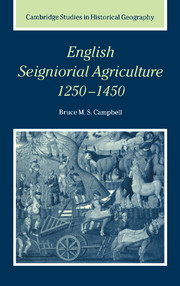Book contents
- Frontmatter
- Contents
- List of figures
- List of tables
- Preface and acknowledgements
- Abbreviations
- Weights, measures, values, and boundaries
- 1 Introduction: agriculture and the late-medieval English economy
- 2 Sources, databases, and typologies
- 3 The scale and composition of the seigniorial sector
- 4 Seigniorial pastoral production
- 5 Seigniorial arable production
- 6 Crop specialisation and cropping systems
- 7 Arable productivity
- 8 Grain output and population: a conundrum
- 9 Adapting to change: English seigniorial agriculture 1250–1450
- Appendix 1 Demesne-level classification of husbandry types
- Appendix 2 Demesnes represented in the Norfolk accounts database
- Appendix 3 Demesnes represented in the FTC accounts databases
- Consolidated bibliography
- Index
- Cambridge Studies in Historical Geography
4 - Seigniorial pastoral production
Published online by Cambridge University Press: 20 October 2009
- Frontmatter
- Contents
- List of figures
- List of tables
- Preface and acknowledgements
- Abbreviations
- Weights, measures, values, and boundaries
- 1 Introduction: agriculture and the late-medieval English economy
- 2 Sources, databases, and typologies
- 3 The scale and composition of the seigniorial sector
- 4 Seigniorial pastoral production
- 5 Seigniorial arable production
- 6 Crop specialisation and cropping systems
- 7 Arable productivity
- 8 Grain output and population: a conundrum
- 9 Adapting to change: English seigniorial agriculture 1250–1450
- Appendix 1 Demesne-level classification of husbandry types
- Appendix 2 Demesnes represented in the Norfolk accounts database
- Appendix 3 Demesnes represented in the FTC accounts databases
- Consolidated bibliography
- Index
- Cambridge Studies in Historical Geography
Summary
Lords, their immediate household members, and their estate officials were medieval England's greatest per capita consumers of livestock and their products. First and foremost, draught animals were required in quantity to work the land and provide transport. Many conventual households maintained expensive cart-horses on their demesnes so that provisions could be delivered in bulk to the central household and cash crops – typically grain and wool – carried to market. Lay lords with substantial itinerant households also required significant numbers of cart and pack animals for their periodic removals from manor to manor. Moreover, it was lords who kept and rode the most prestigious and expensive horses, spending, on Dyer's reckoning, about a tenth of all expenditure on the marshalsea or stable department alone. Good riding horses were costly both to buy and maintain and purpose-bred destriers or war-horses even more so.
Some lords spent as much on textiles – silks, linens, worsteds and, above all, woollens – as they did on transport. What they wore was as much a badge of status as what they rode. Accordingly, they bought woollen cloth in quantity to provide raiment for themselves and their families, liveries for their servants and followers, and a variety of hangings and coverings for their residences. Leather, from hides, was another important article of aristocratic dress, an essential component of all types of armour, and the raw material out of which the finest saddlery and harness were fashioned. It was animal skins, too, which furnished the parchment and vellum consumed in quantity by a class increasingly dependent upon written records.
- Type
- Chapter
- Information
- English Seigniorial Agriculture, 1250–1450 , pp. 102 - 187Publisher: Cambridge University PressPrint publication year: 2000



